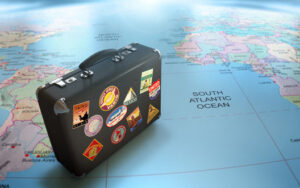
In January-July 2023, international tourism recovered by 84% from the pre-pandemic level of 2019, and an almost complete recovery of the industry is possible by the end of the year, according to the UN World Tourism Organization (UNWTO).
From January to July, 700 million tourist trips were made worldwide, 43% more than in the same period last year. July was the busiest month: 145 million tourist trips were made during this time, which is about 20% of the total for seven months.
“But as the tourism sector recovers, it also needs to adapt. Extreme weather events and overtourism emphasize the need to create a more inclusive, resilient sector to not only ensure the recovery of tourism, but also to redefine it,” said UNWTO Secretary-General Zurab Pololikashvili.
Among the regions of the world, the Middle East, Europe and Africa showed the best results of recovery over the past seven months. According to UNWTO, the Middle East received 20% more tourists than in 2019. European countries have recovered by 91%, driven by strong demand for travel among residents of the region and US citizens. In Africa, the number of tourists reached 92%, in America – 87% of the level of 2019.
In the Asia-Pacific region, the recovery accelerated and reached 61% of pre-pandemic levels after many destinations reopened in late 2022 and early 2023.
“The results show that international tourism is still on the right track and will reach 80-95% of pre-pandemic levels by 2023. The recovery will continue in September-December, albeit at a more moderate pace due to weak demand and a lack of air routes, especially in the Asia-Pacific region, where recovery is still at a moderate level,” the organization explained.
The UNWTO expects that the opening of China and other Asian destinations will continue to stimulate travel both within the region and to other parts of the world.
At the same time, the difficult economic situation continues to hamper the recovery of international tourism in 2023. Persistent inflation and rising oil prices have led to higher transportation and accommodation costs. This may affect tourist spending in the remainder of the year as they increasingly seek value for money, travel closer to home, and take shorter trips.

The number of international travel from January to July 2022 increased to 474 million, which is almost three times more than in the same period last year, according to the UN World Tourism Organization (UNWTO).
“The number of international travel almost tripled from January to July 2022 (plus 172%) compared to the same period in 2021 to 474 million. This means that the industry has recovered 57% from pre-pandemic levels. A sustained recovery in international tourism is being fueled by pent-up travel demand, as well as the lifting or easing of anti-COVID restrictions,” the organization explained.
As noted in the UNWTO, as of mid-September, anti-COVID restrictions ceased to operate in 86 countries around the world.
According to the organization, 207 million international trips were made in June and July 2022, twice as many as in the same period last year. The same months account for 44% of the total number of all arrivals in seven months. Most of the trips were made in Europe – 309 million.
According to the UNWTO, international tourism in Europe and the Middle East is recovering at the fastest pace. From January to July 2022, the number of trips reached 74% and 76% of the 2019 levels, respectively.
“In seven months, the number of international trips in Europe increased by 190% compared to the same period in 2021. This is due to high demand for intra-regional travel, as well as an increase in the number of tourists from the United States. In the Middle East, in January-July 2022, the number of international arrivals almost quadrupled: in July, the number of travels exceeded the pre-pandemic level by 3%, primarily due to pilgrimages to Saudi Arabia,” the organization noted.
As for the Americas, international tourism there recovered to 65% and 60% of the 2019 level and grew by 103% and 171%, respectively, compared to January-July last year.
In the Asia-Pacific region, the number of international travel is still significantly lower (down 86%) compared to 2019. However, compared to 2021, the number of trips increased by 165%.
According to the UNWTO, some sub-regions have been able to restore international travel to 70-85% of pre-pandemic levels. Thus, the Southern Mediterranean, Europe lag behind by 15% from the pre-pandemic 2019, the Caribbean – by 18%, Central America – by 20%, Western and Northern Europe – by 26% and 27%, respectively.

Japan has taken first place in the world ranking of tourist destinations of the World Economic Forum in 2021, despite the closed borders due to the coronavirus pandemic.
“Demand in the tourism sector has been one of the hardest hit by the COVID 19 pandemic, leaving not only businesses but also the tourism-focused national economy hard hit by travel restrictions and international travel suspensions. Fortunately, there are now positive trends – The recovery of the tourism industry has begun, although not at the same pace around the world or in the same market segments. New factors, such as the war in Ukraine, are also complicating this uneven recovery.
According to the organization’s report, the list includes 117 tourist destinations. Japan topped the rankings for the first time, overtaking the US. Spain and France came in third and fourth respectively. The top 10 includes Germany, Switzerland, Australia, the UK, Singapore and Italy.
According to analysts, Japan ranked fourth in the biennial report on air transport infrastructure and cultural resources, sixth in land and port infrastructure, and 12th in natural resources. In terms of resilience to environmental change, the country took only 107th place.
The Travel and Tourism Development Index (TTDI) is based on 18 criteria, including travel and tourism development, business environment, safety, health and hygiene, human resource utilization and labor market, international openness, pricing policy and competitiveness, air transport infrastructure , socio-economic sustainability and others.

The number of international tourist arrivals continued to grow in early 2022 after falling by 70% due to the pandemic, in January the increase was 130% compared to the same month a year earlier, according to the UN World Tourism Organization (UNWTO).
“The number of international tourist arrivals in January increased by 18 million or 130% compared to the same month in 2021. While these figures confirm the positive trend that emerged last year, the recovery of international tourism continues to be hampered by covid restrictions that persist in many countries. In 2021 In 2020, the number of arrivals decreased by 71%, in January 2022 the decrease was 67%,” the report says.
The best results, according to the UNWTO, are in Europe and America, where the number of arrivals increased by 2000 and 100% respectively. But these numbers are still just over 50% behind pre-pandemic flows.
In the Middle East, arrivals increased by 90% in the first month of the year, and by 51% in Africa. This is 63 and 66% less than in 2019. The Asia-Pacific region is recovering the slowest, as several countries remain closed to tourists. The increase in the number of arrivals here amounted to 44%.
But what will happen to tourism after the outbreak of hostilities in Ukraine, the UN World Tourism Organization does not analyze.